Honey Continues to Live in Concord, California
NOTES FROM ABOVE GROUND
By Honey van Blossom
(Honey is a Belgian Marxist former strip-tease artiste)
My house is one of perhaps thirty 1956 houses at the edge of the Canterbury Village subdivision. The thirty houses are regular square houses. Most of the true Canterbury houses are two stories with steep roofs and a brick chimney.
There is no village in Canterbury Village. There are houses and on the nearest main streets commercial businesses but the word “village” does not describe our neighborhood.
The streets of the Canterbury Village are named Shakespeare, Hamlet, Romeo and Juliet, Cape Cod (no cape, and no cod), Chaucer Drive, Pickwick Drive, Lancelot, Churchill, Cobblestone Drive. I live on Shakespeare.
I thought for years that the three men that live on Shakespeare Drive were the same man but recently have been able to distinguish them. They all wear very long gray-brown beards, baseball caps, are stocky, and they all walk in a hunched way as if they had serious back injuries at one time, and maybe they all did. One, however, rides a motorcycle, and another one rides a convertible and plays the same song over and over loudly. The other one just stands at the edge of his lawn. They emerge from different houses.
The song on the radio of the convertible plays:
“Hey-hey.
When everything goes wrong sometimes it makes no sense.
Hey-hey.
There once was a time.
I should have known better then.
Hey-hey.
Although you may try it won’t come your way again.”
One of the three men is The Enforcer. Or maybe all three are enforcers.
The bearded enforcers come out and yell if anyone waters grass or plants in front of their houses. One yells at cars that travel over 25 mph. One only glowers.
My older daughter said that of course I have three enforcers on my block that look the same. After all, I live in Concord. The only thing that surprises her is that there are not more than three stocky middle-aged men who walk all hunched up living on my block.
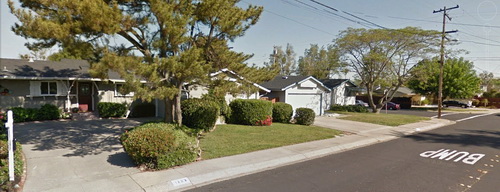
Shakespeare Drive
The first time I saw the lady that lives next door, I saw only her head, which appeared over the decrepit fence in my backyard. Then a woman police officer’s head appeared over the fence. The officer demanded to know if I had seen the tenant. He was a drug dealer, the neighbor said. I had not seen the tenant. I had seen a fat man that looked terrified running out the front door, but that was months earlier.
The neighbor lady, during the years when she still left her house, came to my house to borrow money. She is rather portly and rather old and wore an astonishing Lycra leopard spotted low cut one piece when she went out – but she has not gone outside since February of last year. I don’t know what she does with her hair. It looks like a small furry animal, perhaps a beaver that died and turned red. Her car never worked, and she sometimes came over to ask me to drive her to the bank or to a market or to borrow money. She did not wear shoes. She hit her bare foot against a rise in the path to my house, so I painted a snake on the path to warn her.
A few years ago, she had two new tenants, a man and a woman. They screamed at each other all night long. The man left. His wife wept loudly all night long until she, at last, left. Then my neighbor was alone in the house.
All night long, she screamed at herself about the advantages that had been taken from her. At two a.m. one night, I went over to her house and pounded on the door and told her to shut up. She said she could not because people took advantage of her. I pointed out that I was not one of them. She was silent then but I moved to the bedroom that did not face her house.
A new tenant and his wife moved in. One Sunday morning, three City of Concord patrol cars screeched to a stop in front of the house. “GET ON THE GROUND!” The tenants and the lady dropped to the ground and put their hands out in front of them. The neighbor lady had changed out of the one-piece low cut thing and was wearing a bathrobe that did not quite cover her. One of the tenants on the ground with police guns pointed at him was a burglar on probation.
Hell began in February 2016. Eleven cars, all broken down, parked on the neighbor’s lawn and the new tenants moved in. One of the previously evicted tenants moved back, now with a junk truck. Junk filled up the front yard and the backyard and the side yards. Someone installed an above ground swimming pool against the fence in the backyard.
I called the mosquito abatement people and code enforcement. The code enforcement people told me there was nothing to be done about all the junk – incredibly useless things: seven rusted lawnmowers, a birdhouse on the ground like a bird trap for the delight of cats, dead Christmas trees, a refrigerator, two washing machines, an ancient television set, brooms, a chiminea with a rusted grate, three barbecues and black things that sometimes moved – because all of those things had at one time belonged to my neighbor’s father and mother, she said, who had died in the 1980s. She had, the code enforcement officer told me, to keep the junk because it belonged to the dead parents. I asked if the parents were coming back for it.
The tenants strung up a clothesline in the front yard. They did not wear clothing when their clothes were drying on the line. Flowerpots and a water hose disappeared from my yard.
I had a fence built, a very tall wood fence, to replace the decayed fence. Then I had a smaller fence with a gate built within the area circumscribed by the tall fence.
All the mental people in the vicinity came to visit the many tenants, shaking from anti-psychotic medications. I watched them walk down the street towards my neighbor’s house acting nonchalant. No one bothers to act nonchalant unless there’s a reason to act insouciant and the reason to do that, in Concord, is that you’re crazy.
The mail carrier came through the smaller fence area to bring me my mail.
He said the tenants and their visitors invited him to smoke meth. He declined.
My across-the-street neighbor, married to the convertible owning man, beckoned me to come to the front of her house. I did. She said, “It’s a tweaker house.” During the drought, they replaced their lawn with gravel from the quarry at the edge of Mt. Diablo. Their blinds are never open. Sometimes, this couple stand in front of their house and one yells, “Fuck you!” and the other yells, “No, fuck you!”
The garage next door was briefly empty. A new woman appeared, a regular person dressed in regular clothes. She said she had been my neighbor’s best friend for twenty years. The house had no garbage collection because no one paid the bill, so she paid $1200 in dump fees and a friend of hers had a truck. The house had gone into foreclosure four times, and she paid what was owed each time but it’s enough. She’s going to pay off the $700 PG&E bill. She paid to have the tenants evicted. My neighbor only wore the bathrobe and the one-piece that revealed her wrinkled bosom because the tenants had stolen the rest of her clothes and sold them. They had pulled down the interior walls and sold the lighting fixtures. There were seven old couches pulled into the house, which was dark all the time. She asked, “Who lives like that?”
I asked why she had paid so much money to help my neighbor. The woman answered, “She was my best friend. We used to take trips together. Once we went to Puerto Rico.”
The new owner of the house on the other side of my neighbor’s emerged from her house. She had been burglarized. Even her heater was missing.
One last schizophrenic visitor walked jerkily towards the house last week. She spotted the changes in my neighbor’s house. She sank down on the curb and shook her head and cursed and screamed about the bad things that had happened to her, talking to someone invisible, nonstop, until the patrol cars converged on her.
Cowell Road descends from Ygnacio Valley Road, crosses Shakespeare Drive, and continues to Monument, which becomes Galindo Street downtown, and then Concord Avenue, which heads under the 242 towards the 680. Galindo is the name of the family that married into the Pacheco family, and the Concord Historical Society restored their house. Fernando Pacheco’s adobe is by a small park. Fernando weighed more than 400 pounds and an American carriage maker built him a carriage with a shelf for his belly. His wife was normal sized. They had children. The first generation of Galindos and Pachecos were dark skinned. They married light skinned Americans and their children looked like light skinned fair-haired Americans.
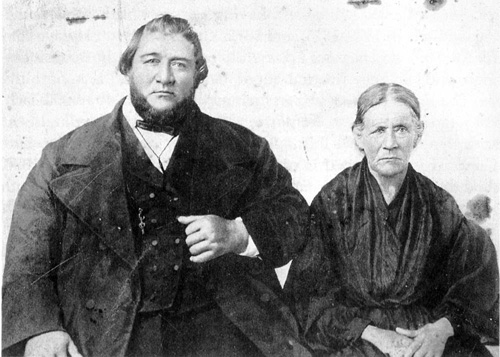
Fernando Pacheco and his mother.
The murders in Concord have, so far, all been in a neighborhood near the 242, an area of older smaller houses. The Mexican-Russian-Polish neighborhood around Monument Boulevard has not had murders.
There is a cemetery behind a fence on Monument, with old-fashioned grave monuments. I have seen no other monument on Monument.
Treat Boulevard crosses Cowell, coming from the direction of Pleasant Hill and then crosses Clayton Road and then dissipates into other suburban streets.
Near the new Mel’s Diner on Treat Boulevard and Clayton Road is a coffee kiosk, a UPS store, a 24-hour liquor store, a Mexican restaurant, an Italian restaurant, and a karate studio. A gas station sits on the eastern corner, a mall with a Safeway and a barbershop on the other. A Staples store, a Radio Shack, the post office, and a CVS stand on the other corner mall.
No one has ever been seen to enter the Radio Shack except that I went in once, startling the young man with hair down to his shoulders playing a video game behind the counter, possibly a descendant of the first Radio Shack clerk.
The hill behind the mall with the Radio Shack is Newhall Park, next to the Turtle Creek development, which has newer and bigger houses. From the park, you can see as far as the Delta. Large oak trees grow in Newhall Park. When the Fages and the Portola Spanish expeditions traveled through Concord towards the end of the eighteenth century, all of what is now Concord contained enormous oak trees, hundreds of years old.
Newhall Park has a “duck pond,” and there is a lot of duck and goose shit on the ground around it. Almost a year ago, a woman’s body was found floating in the duck pond. She was a Safeway security guard. A man accused of her murder was arrested in Reno and extradited. A man’s body was found hanging from a tree in the park in September.
The Vietnam War Memorial is on a hill above the park. Hawks fly so close to this hill you could touch one if you were very fast.
Clayton Road begins near Todos Santos Plaza about three miles from Shakespeare and heads to the town of Clayton. The only difference today between Clayton and Concord is the sign that welcomes drivers to Clayton. Joel Clayton founded Clayton in 1858 as a mining town but it was never a mining town, although miners crossed the hills to get whiskey. Joel Clayton established a vineyard. Until about 1956, when water and sewer systems led to the vast suburban development, this part of Concord was all farms and orchards, and Clayton Road was a dirt road.
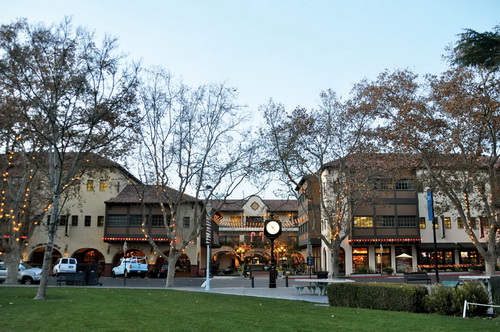
Todos Santos Plaza
Two creeks run through Clayton from Mt. Diablo. If you follow the road past Clayton, it winds past a private golf course, giant oaks, The Farm – a jail – cows, some horses, and goes to Brentwood.
Along Clayton Road in Concord are churches, fast food restaurants, coffee shops, a donut shop, the Salvation Army Church where reformed alcoholics under court order collect junk one level above the junk in my neighbor’s yard, a Good Will,
a law office in a house, a Thai massage therapist in a house, and two thin bands of stores on a narrow parking lot: a vintage furniture store, a foam mattress store, a store that sells hideous loungers and a large naked Nubian woman statue, a used book store, a Filipino grocery store, a junk store, a liquor store, a big room filled with young men that look like the Radio Shack clerk playing board games, a hot dog shop and a Philly cheese steak shop. There’s a store that says it is “Expess.” (No “r”), and a hookah lounge. A building that may be a den of iniquity but there’s a wall up around it and no windows. Old maroon Cadillac cars with trunks that look like caskets park in the lot of this building.
The streets over on the other side of Clayton Road are named Walnut, Elm, Chestnut, Euclid, Grove and Farm Bureau Road. One house on Walnut still has a wood tank house. A Farm Bureau is a farm organization for farmers and ranchers. A tank house is a water tower enclosed by siding, part of a self-contained domestic water system. A windmill pumped water up from the ground up to the tank on top, developed before the advent of electricity and municipal water systems.
The streets on the other side of Clayton Road began as roads between farms. Houses grew there higgledy-piggledy and so the roads between the houses meander. Although all of Concord was once orchards, farms and ranches and before that wheat farms, and before that giant oaks grew, the rest of Concord streets are straight. A large dairy ranch was at the top of all of today’s streets, and it became the Concord Naval Weapons Station and now, no longer a military facility, it is a beautiful big green hill. The Greenbelt Alliance lobbied successfully for cluster real estate development with a lot of open space but I’d prefer it to just be a big green hill forever.
Walking along one street I saw Mt. Diablo’s slopes and then Mt. Diablo disappeared so the road must descend. The clouds parted. I saw pines on the slopes. Indians once climbed the pines and shook down pinecones for the seeds.
Pixieland Amusement Park is across the street from the hill or rather from part of the hill. Pixieland sells tickets to a ride on a miniature railroad, a little track along which runs small Model Ts that children can pretend to drive, something with little airplanes that go up and down, three plastic frogs you sit in that shoots up to about 15 feet and then drops. It opened in 1969, so the first generation of tots to ride the miniature train are about fifty years old now. I used to take my grandchildren but they are all too big now.
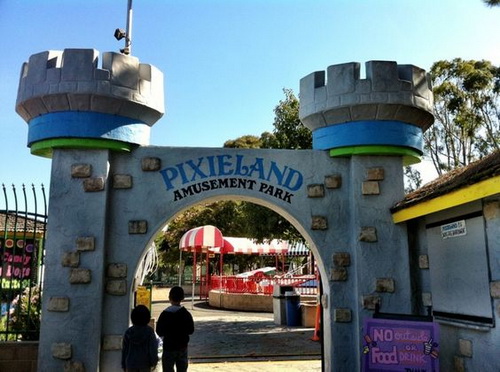
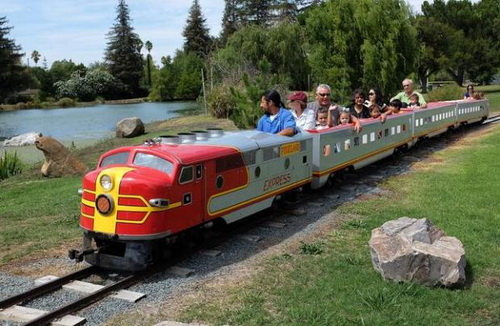
Port Chicago Highway goes through the bottom, a couple of blocks from the house where jazz pianist and composer Dave Brubeck grew up. The Port Chicago disaster occurred on July 17, 1944. Munitions ignited and the explosions killed 320 sailors and civilians. I had heard of the Port Chicago disaster before moving here but assumed it had been in Chicago.
A wood frame building from the early part of the twentieth century is Farm Bureau Store. It sells sodas, cigarettes and junk food now. It may have sold real food a long time ago.
Opposite the Farm Bureau Store is a rather large khaki-painted wood building that looks like an administrative office in a state park. This is now the Concord Historical Research Society. I wrote the society an email and asked if it was the Farm Bureau once. It is open on Tuesday afternoons. Maybe one day I will go there and maybe someone will know why Monument is called Monument.
Early video games had bounded landscapes. You put out fires or shot down air balloons within a confined realm. There was no way to get out of the video games; they just turned around and then you started over in some other place in the animated landscape. If the City of Concord had started with a general plan – it didn’t. It started as an enormous rancho granted Salvio Pacheco by the Mexican government in 1834. His adobe has been turned into an office building on Adobe Street opposite the Indian grocery store. Pacheco wanted the new town to be called Todos Santos. He gave the square to the new town and sold lots at $1 each to the Americans after the town of Pacheco was flooded. Before that, native Americans lived here in villages and caught salmon and hunted giant antelope. But if it had been a planned city, which it was not except for the plan sketched in Pacheco’s brain, then the first general plan map would have had to have been like one of those early video games.
In reality, which I suppose the modern city of Concord is in, you can get out of the confined realm. Many people must commute every day. The 680, the 4, and the 242 are clogged during rush hours. BART train cars are filled. The commuters all go somewhere, some only to other confined realms but many to the real cities of Berkeley, Oakland, San Jose and San Francisco, cities where people congregate, go to the theater and museums and hold political rallies.
Today, on the spring equinox, I walked further than I had before on the other side of Clayton Road in Concord. I met no other walker. I saw no one working in her yard. The people that live in the houses stayed inside. Most of the driveways stored several cars, possibly escape cars, but many were forty years old cars, which is old for a car. The loneliness of separate houses with fences between them caught me by the throat. When people first moved out to Concord maybe neighbors had barbecues, maybe they celebrated Halloween and the Fourth of July together. Now, they stay inside. One house flies an American flag. One flies only the Republic of California flag, meaning the people in that house want California to secede from the union. One flag has a black field with stars and black and white stripes with a thick blue stripe through it. This flag is to show support for the police.
The isolation of the houses of suburban California is the built version of the American Dream, each family – or each single person – alone and believing they are independent and self-sufficient and that, because they own property, the government should be limited to the police and to war. The reality is that government paid for the freeways that led into what was country. VA loans with racial biases – paid for by all taxpayers no matter what their color – made the down payments. Developers harvested the profit. Appliance manufacturers benefited because each kitchen had to have its own appliances. Automobile manufacturers profited because people traveled long distances on the freeways to find work.
Suburban land development then shaped how people felt about the world.
The yards sometimes contained plaster or concrete ducks, deer, turtles and other beasts no one sees anymore except for ducks in the creeks. Sometime in the past, people had planted the marvelous California Redbud. Its blossoms are the color of raspberry sherbet. Pink blossoms on peach trees, white blossoms on plum trees, orange globes hung heavily on trees with shiny green leaves but no one has gathered the fruit and it lies like jewels in the weeds. The nacreous sky above the streets dulled the vibrant trees planted forty or fifty or a hundred years ago. If it did not, the spring after this rainy winter would have been unbearably beautiful.
Mt. Diablo and its slopes appeared ahead of me, and it should not have. This meant I was headed a way that would have taken me all the way to Kirker Pass – an extension of Ygnacio Valley Road – which leads to Pittsburg. The hills on each side of the pass are beautiful.
I turned and saw the green hill ahead instead and found West Street.
I followed West Street away from the hill and reached Clayton Road and followed it to Cape Cod. I passed the opening in a fence that leads into the Markham tree park on one side of the street and on the other, the path along the creek now filled with rushing water, and from there, to Shakespeare.
I opened the gate in the fence to my yard, walked through the gate into the yard, went up the two concrete steps and opened my front door.
Comments
Leave a Reply
You must be logged in to post a comment.



